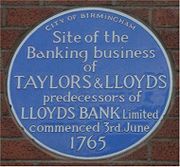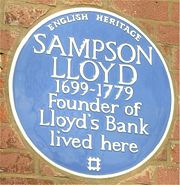
Sampson Lloyd
Encyclopedia


Birmingham
Birmingham is a city and metropolitan borough in the West Midlands of England. It is the most populous British city outside the capital London, with a population of 1,036,900 , and lies at the heart of the West Midlands conurbation, the second most populous urban area in the United Kingdom with a...
, England
England
England is a country that is part of the United Kingdom. It shares land borders with Scotland to the north and Wales to the west; the Irish Sea is to the north west, the Celtic Sea to the south west, with the North Sea to the east and the English Channel to the south separating it from continental...
. The second co-founded Lloyds Bank
Lloyds Bank
Lloyds Bank Plc was a British retail bank which operated in England and Wales from 1765 until its merger into Lloyds TSB in 1995; it remains a registered company but is currently dormant. It expanded during the nineteenth and twentieth centuries and took over a number of smaller banking companies...
.
Sampson Lloyd I and Mary (née Crowley, brother of Ambrose Crowley
Ambrose Crowley
Sir Ambrose Crowley III was a 17th century English ironmonger.-Early years:He was the son of Ambrose Crowley II , a Quaker Blacksmith in Stourbridge but rose Dick Whittington-style to become Sheriff of London .-Career:...
), Quakers of Welsh origin
Welsh people
The Welsh people are an ethnic group and nation associated with Wales and the Welsh language.John Davies argues that the origin of the "Welsh nation" can be traced to the late 4th and early 5th centuries, following the Roman departure from Britain, although Brythonic Celtic languages seem to have...
, moved from their Leominster
Leominster
Leominster is a market town in Herefordshire, England, located approximately north of the city of Hereford and south of Ludlow, at...
, Herefordshire
Herefordshire
Herefordshire is a historic and ceremonial county in the West Midlands region of England. For Eurostat purposes it is a NUTS 3 region and is one of three counties that comprise the "Herefordshire, Worcestershire and Gloucestershire" NUTS 2 region. It also forms a unitary district known as the...
farm in 1698 to Edgbaston Street in Birmingham
Birmingham
Birmingham is a city and metropolitan borough in the West Midlands of England. It is the most populous British city outside the capital London, with a population of 1,036,900 , and lies at the heart of the West Midlands conurbation, the second most populous urban area in the United Kingdom with a...
.
After the death of Sampson I in 1725 his sons Charles and Sampson II bought the Town Mill and traded in iron. Sampson II also bought a forge in Burton upon Trent
Burton upon Trent
Burton upon Trent, also known as Burton-on-Trent or simply Burton, is a town straddling the River Trent in the east of Staffordshire, England. Its associated adjective is "Burtonian"....
. After Charles' death in 1741, Sampson II became wealthy and in 1742 bought an Elizabethan
Elizabethan era
The Elizabethan era was the epoch in English history of Queen Elizabeth I's reign . Historians often depict it as the golden age in English history...
house in (then rural) Sparkbrook
Sparkbrook
Sparkbrook is an inner-city area in south-east Birmingham, England. It is one of the four wards forming the Hall Green formal district within Birmingham City Council.-Etymology:...
called "The Farm" for £1,290. He built a Georgian house
Georgian architecture
Georgian architecture is the name given in most English-speaking countries to the set of architectural styles current between 1720 and 1840. It is eponymous for the first four British monarchs of the House of Hanover—George I of Great Britain, George II of Great Britain, George III of the United...
there, now a grade II* listed building, but continued to live in Edgbaston Street.
In 1765, at the age of 66, he formed a company with the button maker John Taylor (1711–1775) and his own son, Sampson III, creating Birmingham's first bank: Taylor's and Lloyds, located at 7 Dale End. This is the bank which became Lloyds Bank
Lloyds Bank
Lloyds Bank Plc was a British retail bank which operated in England and Wales from 1765 until its merger into Lloyds TSB in 1995; it remains a registered company but is currently dormant. It expanded during the nineteenth and twentieth centuries and took over a number of smaller banking companies...
, and then Lloyds TSB
Lloyds TSB
Lloyds TSB Bank Plc is a retail bank in the United Kingdom. It was established in 1995 by the merger of Lloyds Bank, established in Birmingham, England in 1765 and traditionally considered one of the Big Four clearing banks, with the TSB Group which traces its origins to 1810...
.
His son, Sampson III, formed another company, Taylor, Lloyd, Hanbury and Bowman in Lombard Street
Lombard Street
There are several famous Lombard Streets:* Lombard Street , famed for its twists and turns* Lombard Street, London, leading from the Bank of England to Gracechurch Street...
in London
London
London is the capital city of :England and the :United Kingdom, the largest metropolitan area in the United Kingdom, and the largest urban zone in the European Union by most measures. Located on the River Thames, London has been a major settlement for two millennia, its history going back to its...
.
Another son of Sampson II, Charles Lloyd (1748–1828), was also a partner in the bank as well as a poet and campaigner against slavery
Slavery
Slavery is a system under which people are treated as property to be bought and sold, and are forced to work. Slaves can be held against their will from the time of their capture, purchase or birth, and deprived of the right to leave, to refuse to work, or to demand compensation...
. He lived, and died, in Bingley House on Broad Street
Broad Street, Birmingham
Broad Street is a major thoroughfare and popular nightspot in Birmingham City Centre, United Kingdom. Traditionally, Broad Street was considered to be outside Birmingham City Centre, but as the city centre expanded with the removal of the Inner Ring Road, Broad Street has been incorporated into...
, later demolished to build the Bingley Hall
Bingley Hall
Bingley Hall in Birmingham was the first purpose-built exhibition hall in Great Britain. It was built in 1850 and burned down in 1984. The International Convention Centre now stands on the site....
, itself demolished for the International Convention Centre
International Convention Centre, Birmingham
The International Convention Centre is a major conference venue in central Birmingham, England. The centre includes Symphony Hall and it faces Centenary Square. The building has another entrance leading to the canals of Birmingham. The Convention Quarter area, which includes Brindleyplace, is...
and Symphony Hall
Symphony Hall, Birmingham
Symphony Hall is a 2,262 seat concert venue located inside the International Convention Centre in Birmingham, England. It was officially opened by the Queen in June 1991, although had been opened on April 15, 1991. It is home to the City of Birmingham Symphony Orchestra and hosts around 270 events...
. His son, Charles Lloyd II
Charles Lloyd (poet)
Charles Lloyd II , poet, was a friend of Charles Lamb, Samuel Taylor Coleridge, and Thomas de Quincey. His best-known poem is "Desultory Thoughts in London".-Early life:...
, unsuccessful poet, was only briefly involved in the bank and moved to Versailles
Versailles
Versailles , a city renowned for its château, the Palace of Versailles, was the de facto capital of the kingdom of France for over a century, from 1682 to 1789. It is now a wealthy suburb of Paris and remains an important administrative and judicial centre...
and died in 1839.
Sources
- A History of Birmingham, Chris Upton, 1993, ISBN 0-85033-870-0
- The Lloyds of Lloyds Bank - An examination into Family History, Gilbert.

